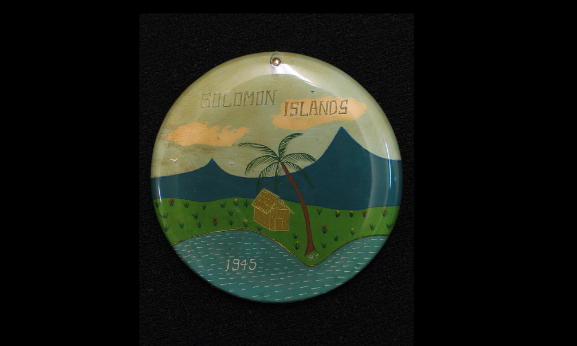Recently, the Air Force Museum was honoured to host RNZAF veteran Ron Hermanns’ 108th birthday. Ron’s distinction as New Zealand’s oldest man made this momentous event even more significant, and many special guests were present. It was also an opportunity for us to showcase a remarkable collection of jewellery and souvenirs that Ron made during his time in service, and which he generously donated to the Museum in 2009. The pieces are fine examples of decorative items known as ‘trench art’; some are on permanent display at the Museum, while others were brought out specially to mark the occasion.
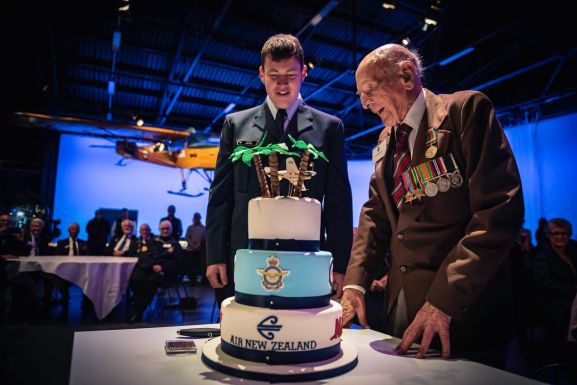
Ron’s background
Ron was born in Canada in 1911, and came to New Zealand with his family in 1914. He trained as an engineer and worked in the Railway Workshops in Wellington. In 1937 Ron joined the Wellington Territorial Squadron as an aircraft rigger, working on Blackburn Baffin biplanes. With the outbreak of war in 1939, he was made liable for continuous service and joined the RNZAF.
At that point, Ron changed trade to become an aircraft fitter and was initially stationed at Woodbourne, then posted around New Zealand. In early 1943 he was deployed overseas, to No. 4 Repair Depot at Espiritu Santo in the New Hebrides (now Vanuatu). There, he spent 12 months working with the Americans and servicing the RNZAF’s Kittyhawks. Personnel on active service were not permitted to keep diaries but Ron wrote one once the war was over, based on his letters home and general recollections. It is now kept at the Alexander Turnbull Library and offers many insights into everyday life in RNZAF Servicing Units in the Pacific during World War Two. All direct quotes in this post are drawn from Ron’s diary.
A knack for making things
Those at Ron’s birthday heard of a handyman, still making and using tools, building fences and generally maintaining his property. Ron’s diary entries demonstrate that this has always been the case, describing furniture, water boilers, spouting systems, a washing machine, and other devices that he knocked together to make life in the Pacific more comfortable.
Considering his bent for construction and overall ingenuity, it is no surprise that Ron also turned his hand to making decorative items in his spare time. While in Espiritu Santo, Ron mentions that he made buttons, bangles and napkin rings from coconut shell, bamboo and ivory nut. He also describes going into the jungle to collect seeds to make into necklaces – of which 20 were destined for friends in New Zealand. Ron was not alone in making these, and records that they were popular items for purchase among the American servicemen, the going rate being two dollars per necklace. Other items were lucrative too:
“Several of the boys have sent to N.Z for souvenirs such as tikis, kiwis, etc. made of silver or in leather work. The sell them to the Yanks for about three times their N.Z. price”.
Here, Ron is describing the manufacture and trade of ‘trench art’. The term has a broad definition: keepsakes made by a solider in a trench during World War One and intended for a loved one would certainly qualify, but any item made in association with armed conflict can be considered trench art. This can include items crafted as individual gifts, or those produced en masse to supply a robust market for souvenirs. Judging by Ron’s description, the latter may have applied on Espiritu Santo, as it did in other parts of the Pacific.
Ron’s Second Tour

From the collection of the Air Force Museum of New Zealand.
Ron stayed on Espiritu Santo until early February 1944, when he returned to Wellington. In January 1945, he embarked on his second tour of operations. This time, Ron was based for five months at No. 12 Servicing Unit at Henderson Field on Guadalcanal in the Solomon Islands, maintaining Lockheed Venturas. Following that, he was posted to Jacquinot Bay, New Britain (now part of Papua New Guinea), where he remained with No. 3 Servicing Unit, working with RNZAF Corsairs, until November 1945.
The items in the Museum’s collection date from Ron’s second overseas deployment, and the conditions under which they were made were a bit different to those of his first tour. Not long after arriving in Guadalcanal, Ron notes in his diary that rules had changed since the last time he was away: making and selling things to the Americans was now prohibited, despite it having been “a great hobby overseas”. ‘The Yanks’ weren’t subject to the same restrictions, in fact, Ron adds that they were even “encouraged in that direction”. It seems the New Zealanders found a work-around by supplying the Americans with merchandise: “at least half the stuff they sell is made by our boys on the sly”.
Ron also found that the raw materials he’d used for his hobby while on ‘Santo’ weren’t so readily available on Guadalcanal. Unfazed, he turned to a range of surplus and scavenged everyday products, an approach which is also characteristic of trench art. He re-purposed these materials with the aid of hacksaws, small files and drills, abrasive paper, and metal polish.
Materials and Techniques
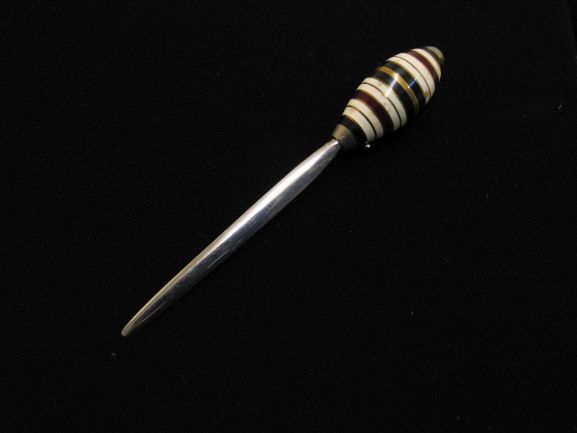

Ron made several letter openers from flying wire, a utilitarian airframe component, which he finished in chrome. In a couple, he stacked and shaped brass with Bakelite gaming chips to form striped handles. For another he used .303 bullets and cartridge shells.
The red paint that decorates the edges of the ‘bullet knife’ appears frequently in Ron’s work. Another example is a tie pin made from a New Zealand florin – the precursor to the 20-cent piece – where red paint highlights the kiwi’s eye. The image of the bird has been painstakingly removed from the centre of the coin, attached to a pin and plated with chrome. Ron created a whole range of tie pins in a similar way, many of them also from pre-decimal New Zealand currency.

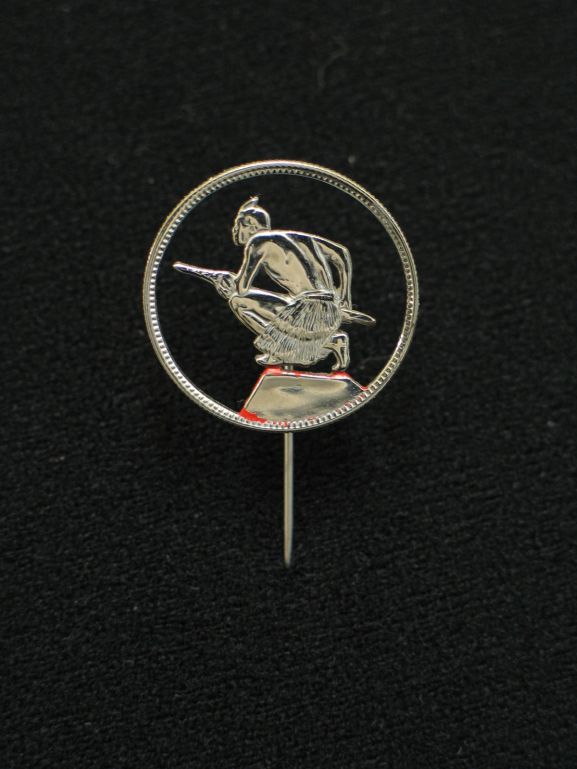
Duralumin is an aluminium-copper alloy used in the aviation industry. It was developed by the Germans who used it in aircraft skins and frames during World War One. It was subsequently adopted more widely – particularly for use in air ships. Duralumin hardens slowly, a property that would make it convenient to shape and work. It appears in several of Ron’s designs, usually as a component, but most strikingly as the principal material of the sole necklace in the collection.

Acrylic, (often referred to by trade names Perspex or Plexiglass) was sourced from aircraft windscreens. It was a favourite material of trench artists because it was easy to work; it could be cut and filed, inscribed, painted, and polished to a smooth finish. When heated, it becomes soft and can be moulded into shapes which hold once the acrylic has cooled. Ron used acrylic extensively in rings, bangles, brooches and letter openers, either on its own or embellished with other materials, engraving, or paint. A magnificent coiled snake demonstrates the versatility of acrylic. Heat moulded, a pattern has been imprinted into the underside, which has then been painted.
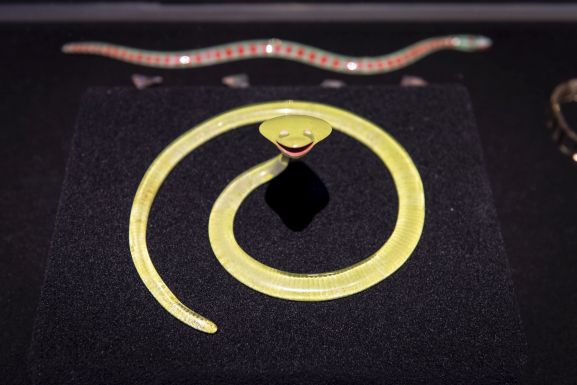
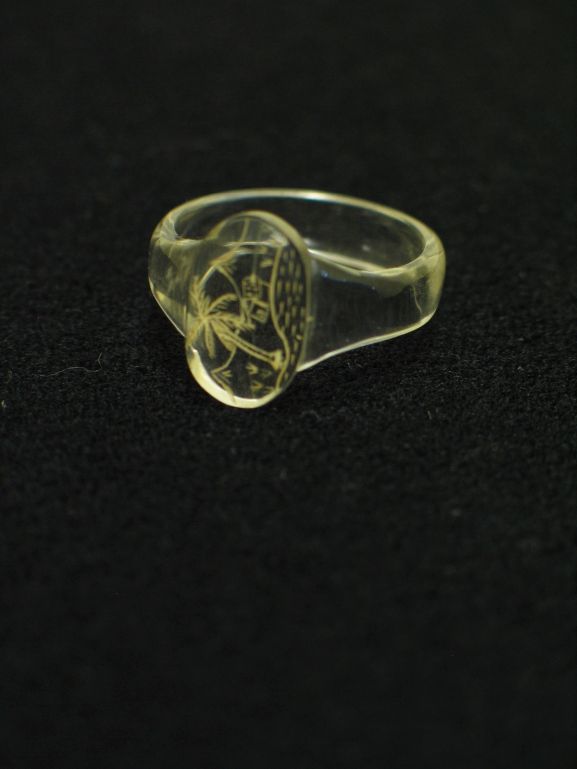
Ron also made wide use of paua shell, which he attached to mounts of stainless steel, duralumin, Bakelite or acrylic. He had gathered shells from Lyall Bay in Wellington between postings, fossicking specifically so that he would have material to work with when he returned to the Pacific. It seems Ron was not the only one to have had a supply of paua shell and was fortunate to have collected enough for his own use, noting “some others brought more with them than they want and are selling them for a $1 each”.

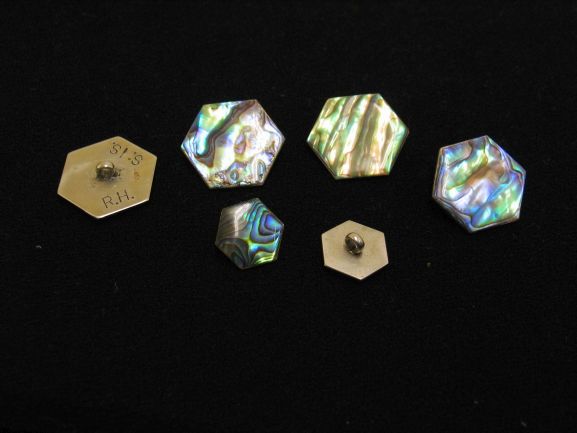

Several of Ron’s designs directly reference the places where he was stationed, and an engraved plexiglass panel shows the approximate route that he took on his second tour: sailing from New Zealand to Espiritu Santo, then to Guadalcanal, before later flying to New Britain. Others – such as an acrylic hei-tiki – feature motifs distinct to Aoteoroa. Representations of Australia may reflect a level of demand from Australian personnel, as New Britain was a mandated territory of Australia at the time.
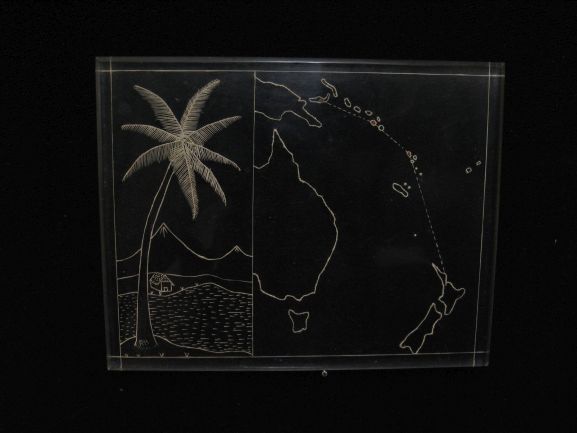


The quality of trench art varies widely depending on the skills of the maker, the resources available to them, and their circumstances. Ron Hermanns’ exacting eye, proficiency with tools and general ingenuity combined to see him create a distinctive collection of objects in his spare time. The Air Force Museum is fortunate to have them in its collection, and to be able to celebrate Ron.
References
Hermanns, Ronald. ‘Santos Diary’. Held at Alexander Turnbull Library, Wellington, New Zealand. Reference number MSX-8163.




